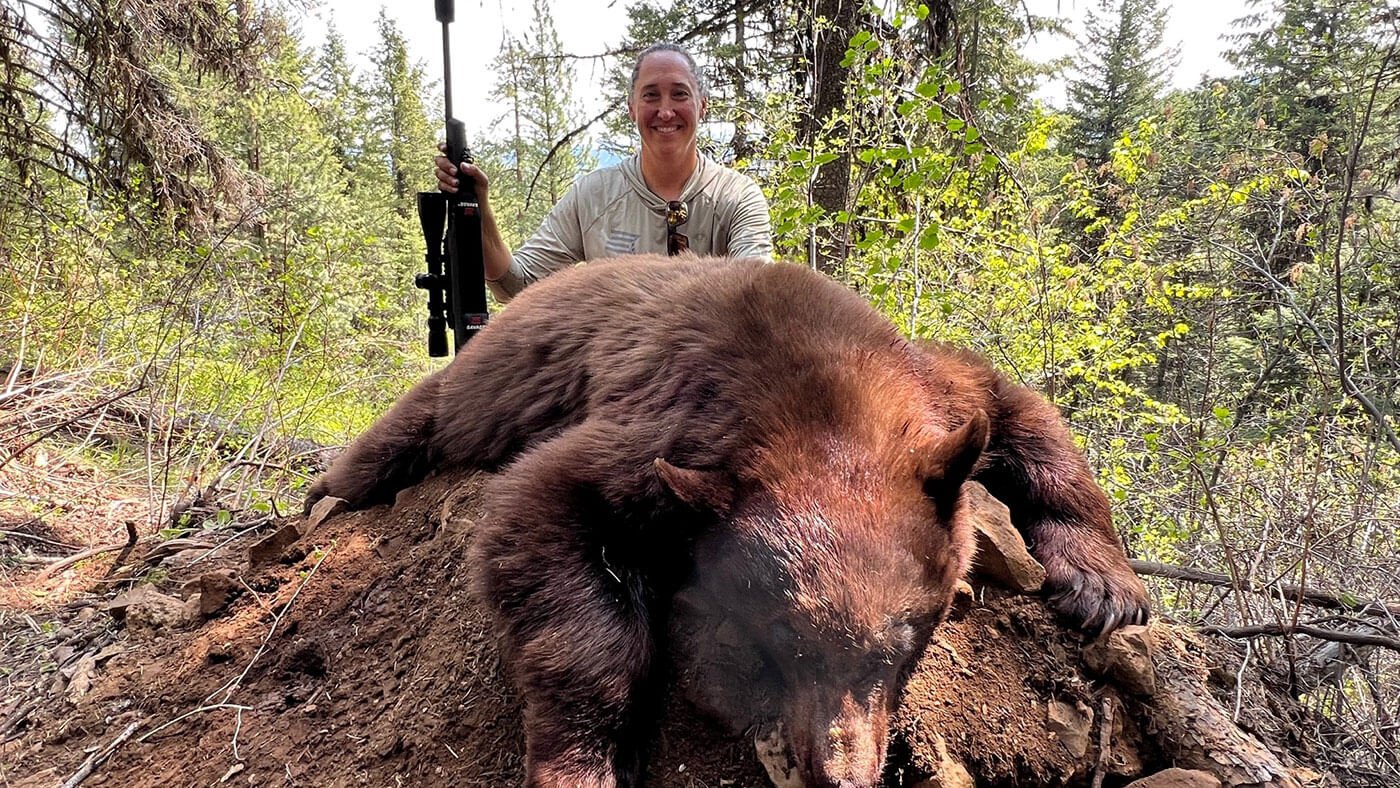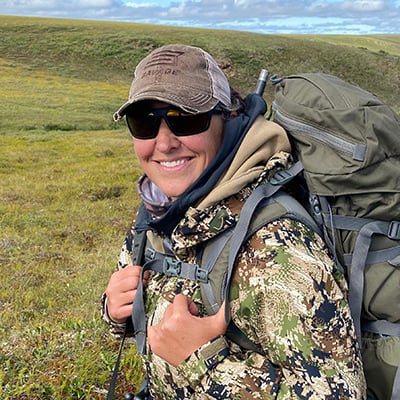- Savage Blog
- How Bear Hunting with Hounds and Bait Changed My Perspective
How Bear Hunting with Hounds and Bait Changed My Perspective

When I was approached to attend an event with top industry writers in the beautiful mountains of Idaho, I did not hesitate to say yes. I am a sucker for beautiful places, mountains, and tackling new challenges as I expand my hunting career. As I learned more about the event and the type of hunting we would be doing, I started to second guess if I should go. We were going to be hunting spring black bear. My initial thought was, didn’t the bears just come out of hibernation, why would we hunt them now? Seems unfair if you ask me.
The style of hunting was nothing I had done before, at least not in this exact scenario. I have done driven hunts where dogs were used to push game around. I’ve sat over a feeder for whitetail in Texas as that is the main way deer in Texas get food, but I had never sat over bait before in this manner, waiting for an animal to walk in enticed by a concoction of grains, sweet treats, and scented sprays. The two forms of hunting made me apprehensive about not only how I would feel harvesting an animal in this way, but how would I explain this to family and friends who may see this as cheating, or unethical hunting.
To take a step back, I did not come from a hunting family or group of friends. Hunting has been new to me since joining the firearm industry 7 years ago, and not only have I learned a tremendous amount about hunting, conservation, and wildlife management in that time, but I have also tried to inform and educate those in my inner circle who want to listen and learn. I have taken great strides in continuing to expand my knowledge of why we hunt, how hunters impact our world, and how the role I play can help us keep this new hunter cycle growing for our future.
People who come to our home and see my mounts or eat the meat I have harvested are intrigued to hear about the hunt, learn about the species, and hear what every hunter loves to tell, the story of how it all went down. There is a sense of pride I take in helping open people’s eyes to a world they have not had exposure to, but more importantly, help dispel myths they may have about what we hunters do and the role we play in the conservation and management of wildlife.
So back to Idaho, spring bears, bait, and hounds. Before the trip I had people asking me a lot of questions, and as I mentioned, I was asking them myself. Why hunt bears when they just come out of hibernation? Aren’t they small? Haven’t the sows just had cubs? This time of year, there are strict laws in place that allow hunters to only harvest boars or sows without cubs. I learned that hunting bears in the spring helps manage the population density of bears, especially boars. This management allows for less cannibalization among other bears, cubs, elk calves, and fawns, which boars will actively pursue when they are hungry. Every type of hunting is focused on wildlife management and protecting the future of the species, and those species who share their land and their habitat.
The main concern I had as did others I was talking with was about the method of the hunt. Isn’t hunting with dogs and over bait cheating, is that really even hunting? Boy, was I educated on this trip. I struggle with where to begin on the topic that has changed my view of both hounds and bait hunting.

The first morning, at dawn, we are behind the lodge watching our guides load up the 3 different sets of hunting hounds. The species we are using are treeing walker coonhound. The dogs were eager to hit the woods and get to work. I learned a tremendous amount about these animals during my time with them. We had hounds ranging from 6 months to 13 years of age with us. It was fascinating to learn that these hounds are trained by being with the other dogs and observing. There is no formal training. No special techniques are used to teach them the ropes. These dogs are built to do what they do, get on the scents, follow the trail, and get the animal either bayed or treed.
We watched from the truck on GPS devices as the dogs got to work, hot on the scent of a bear. There were clear lead dogs and clear pack dogs. The first two days, our pack got on the scent immediately. But nothing came of it and the trail went cold. We spent hours in the truck navigating the winding tight forest roads trying to catch up and retrieve the hounds. Each of the first two days with the hounds proved unsuccessful. Dogs got on scents but lost them shortly after the chase ensued. What I thought was going to be an easy hunt, was turning out to be just the opposite. Not physically demanding like other hunts I have participated in, but more mentally challenging. Your emotions burst into excitement when the dogs take off and start chasing. Quick lows ensue when you see them searching in circles or turning back towards us at the truck. We spent over 7 hours each of the first two days chasing the dogs. In all that time, we did not see a single bear. Not one in the woods, not one running along a hillside. We saw nothing.

After mornings with unsuccessful hunts with the hounds, it was time to sit over bait in the evenings. Again, my preconceived ideas were that this style of hunting would be easy. You put out the good stuff, grains, grease, or frosting in some cases in a barrel, and put a hunter 50-100 yards away! I was given a collapsible lawn chair and then had a small berm on a hillside pointed out to me. This is where I would spend the next four and a half hours. Sitting exposed, on a hillside, fifty yards from a bait barrel. While the scenery was gorgeous, I saw a wonderful sunset over the mountain, no bears were seen in my first sit. Myth number two of hunting over bait was starting to show cracks.
I repeated this same process the following night. Again, thinking that a bear would easily come into the scent of fresh bait. I sat as quietly as I could, as bears' hearing is three times as strong as humans'. Staying downwind from the bait, as their sense of smell is their strongest tool in their arsenal. Yet after a total of ten hours sitting over bait in two days, not a bear was seen. That puts our total hunt time at over 24 hours in 2 days, and in all that time, all that driving, zero bears were spotted. This had me starting to understand that hunting with hounds and over bait is not cheating, they are a necessary hunting method to properly manage these animals in this environment. These are smart animals, with keen senses who navigate their environment very well.
Two days of ups and downs while chasing bears were behind us, however day three was a different story. We loaded up and drove over two hours to our hunting location. Our hounds were sounding off before we even stopped the truck near the bait barrel. We released the first few and they were off. After a few sharp turns, the lead group got on a scent. We watched as some of the younger dogs who fell off the trail returned to the truck. After thirty minutes, my guide could tell that the dogs were on a bear, and either had it treed or bayed at the base of a tree. All the dogs had stopped moving, all were barking at 40 barks per minute or more. It was time for us to catch up.
It took us over a half hour to maneuver the terrain that the dogs did in minutes. We crossed multiple creeks, climbed ridges, and dropped into valleys, eventually climbing one final ridge, nearly to the top. Our GPS told us we were 300 yards from the dogs, but we could not hear a bark. The steep terrain, trees, and foliage were that thick. As we approached, we could see the dogs at the base of a tree and found a cinnamon color phase bear 35 feet up in the tree. After securing the dogs, I was able to put a shot on the bear with a Savage Impulse Driven Hunter and quickly harvest the beautiful animal.

The dogs had done their job. It was very evident that all the dogs want to do is their job, and be recognized by their owner. Each hound was rewarded by coming to sniff and engage with the bear. There are no special treats, no additional rest, the mere fact that the dogs earned this praise is what motivates them. As we processed the bear in the field, the dogs simply sat and rested and watched us. Their work was done.

Every hunt I go on teaches me new things and I bring home new stories and memories. This one taught me a lot more than others. This hunt changed my perception of two different hunting methods. I learned not only the how, but more importantly, the why we hunt in these manners. People who do not hunt, or do not hunt in this way, will always struggle to understand, but I looked at it this way: Is a food plot not bait? Don’t we use that to get whitetail into range of our stands? During the rut, don’t we follow or try to lure the does to find the bucks and bulls? I guess it’s all in how you want to view the situation, but for me, I now have a much wider lens through which I analyze this type of hunting, and I am grateful for that.

